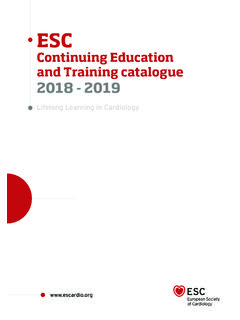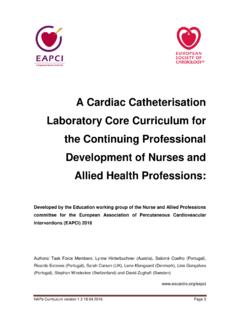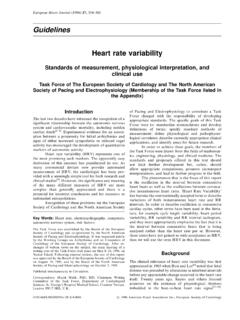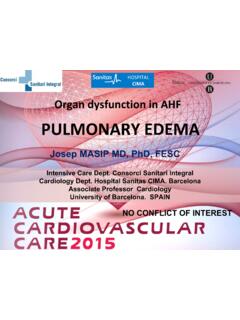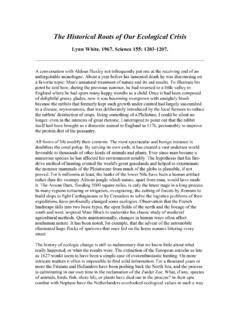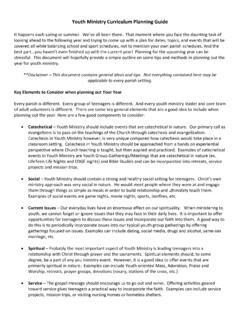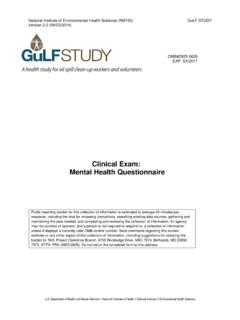Transcription of 2016 ESC Guidelines for the diagnosis and treatment of ...
1 ESC GUIDELINES2016 ESC Guidelines for the diagnosisand treatment of acute and chronic heartfailure Web AddendaThe Task Force for the diagnosis and treatment of acute and chronicheart failure of the European Society of Cardiology (ESC)Developed with the special contribution of the Heart FailureAssociation (HFA) of the ESCA uthors/Task Force Members: Piotr Ponikowski*(Chairperson) (Poland),Adriaan A. Voors*(Co-Chairperson) (The Netherlands), Stefan D. Anker (Germany),He ctor Bueno (Spain), John G. F. Cleland (UK), Andrew J. S. Coats (UK), Volkmar Falk(Germany), Jose Ramo nGonza lez-Juanatey (Spain), Veli-Pekka Harjola (Finland),Ewa A. Jankowska (Poland), Mariell Jessup (USA), Cecilia Linde (Sweden),Petros Nihoyannopoulos (UK), John T. Parissis (Greece), Burkert Pieske (Germany),Jillian P. Riley (UK), Giuseppe M. C. Rosano (UK/Italy), Luis M. Ruilope (Spain),Frank Ruschitzka (Switzerland), Frans H. Rutten (The Netherlands),Peter van der Meer (The Netherlands)Document Reviewers: Gerasimos Filippatos (CPG Review Coordinator) (Greece), John J.
2 V. McMurray (CPGR eview Coordinator) (UK), Victor Aboyans (France), Stephan Achenbach (Germany), Stefan Agewall (Norway),Nawwar Al-Attar (UK), John James Atherton (Australia), Johann Bauersachs (Germany), A. John Camm (UK),*Corresponding authors: Piotr Ponikowski, Department of Heart Diseases, Wroclaw Medical University, Centre for Heart Diseases, Military Hospital, ul. Weigla 5, 50-981 Wroclaw,Poland, Tel:+48 261 660 279, Tel/Fax:+48 261 660 237, Voors, Cardiology, University of Groningen, University Medical Center Groningen, Hanzeplein 1, PO Box , 9700 RB Groningen, The Netherlands. Tel:+31 50 3612355,Fax:+31 50 3614391, Committee for Practice Guidelines (CPG) and National Cardiac Societies document reviewers: listed in thefull text entities having participated in the development of this document:Associations: Acute Cardiovascular Care Association (ACCA), European Association for Cardiovascular Prevention and Rehabilitation (EACPR), European Association of Cardio-vascular Imaging (EACVI), European Heart Rhythm Association (EHRA), Heart Failure Association (HFA).
3 Councils: Council on Cardiovascular Nursing and Allied Professions, Council for Cardiology Practice, Council on Cardiovascular Primary Care, Council on Groups: Cardiovascular Pharmacotherapy, Cardiovascular Surgery, Myocardial and Pericardial Diseases, Myocardial Function, Pulmonary Circulation and Right VentricularFunction, Valvular Heart content of these European Society of Cardiology (ESC) Guidelines has been published for personal and educational use only. No commercial use is authorized. No part of the ESCG uidelines may be translated or reproduced in any form without written permission from the ESC. Permission can be obtained upon submission of a written request to Oxford Uni-versity Press, the publisher of the European Heart Journal and the party authorized to handle such permissions on behalf of the ESC The ESC Guidelines represent the views of the ESC and were produced after careful consideration of the scientific and medical knowledge and the evidence available atthe time of their publication.
4 The ESC is not responsible in the event of any contradiction, discrepancy and/or ambiguity between the ESC Guidelines and any other official recom-mendations or Guidelines issued by the relevant public health authorities, in particular in relation to good use of healthcare or therapeutic strategies. Health professionals are encour-aged to take the ESC Guidelines fully into account when exercising their clinical judgment, as well as in the determination and the implementation of preventive, diagnostic ortherapeutic medical strategies; however, the ESC Guidelines do not override, in any way whatsoever, the individual responsibility of health professionals to make appropriate andaccurate decisions in consideration of each patient s health condition and in consultation with that patient and, where appropriate and/or necessary, the patient s caregiver. Nordo the ESC Guidelines exempt health professionals from taking into full and careful consideration the relevant official updated recommendations or Guidelines issued by the competentpublic health authorities, in order to manage each patient s case in light of the scientifically accepted data pursuant to their respective ethical and professional obligations.
5 It is also thehealth professional s responsibility to verify the applicable rules and regulations relating to drugs and medical devices at the time of article has been co-published with permission inEuropean Heart JournalandEuropean Journal of Heart rights reserved in respect ofEuropean Heart Society of Cardiology 2016. All rights reserved. For permissions please email: Heart Carerj (Italy), Claudio Ceconi (Italy), Antonio Coca (Spain), Perry Elliott (UK), etin Erol (Turkey),Justin Ezekowitz (Canada), Covadonga Ferna ndez-Golf n (Spain), Donna Fitzsimons (UK), Marco Guazzi (Italy),Maxime Guenoun (France), Gerd Hasenfuss (Germany), Gerhard Hindricks (Germany), Arno W. Hoes (TheNetherlands), Bernard Iung (France), Tiny Jaarsma (Sweden), Paulus Kirchhof (UK/Germany), Juhani Knuuti(Finland), Philippe Kolh (Belgium), Stavros Konstantinides (Germany/Greece), Mitja Lainscak (Slovenia),Patrizio Lancellotti (Belgium), Gregory Y.
6 H. Lip (UK), Francesco Maisano (Switzerland), Christian Mueller(Switzerland), Mark C. Petrie (UK), Massimo F. Piepoli (Italy), Silvia G. Priori (Italy), Adam Torbicki (Poland),Hiroyuki Tsutsui (Japan), Dirk J. van Veldhuisen (The Netherlands), Stephan Windecker (Switzerland),Clyde Yancy (USA), Jose Luis Zamorano (Spain)The disclosure forms of all experts involved in the development of these Guidelines are available on the ESC Heart failure Natriuretic peptides Ejection fraction diagnosis Pharmacotherapy Neuro-hormonal antagonists Cardiac resynchronization therapy Mechanical circulatory support Transplantation Arrhythmias Co-morbidities Hospitalization Multidisciplinary managementWeb Contents1. Web Tables ..3 Web Table New York Heart Association functionalclassification based on severity of symptoms and physicalactivity .. 3 Web Table ACCF/AHA stages of heart failure .. 3 Web Table Markers of worse prognosis in patients withheart failure.
7 3 Web Table Typical demographics and co-morbiditiesassociated with heart failure with preserved ejectionfraction .. 4 Web Table normal and abnormal values ofechocardiographic indices of diastolic function of left ventricleat rest according to age categories, differentiated for are presented as means (+standard deviations) (thecut-offs of these parameters have been derived from thefollowing references) .. 4 Web Table Diagnostic tests for specific causes of heartfailure with preserved ejection fraction .. 5 Web Table Major clinical trials of therapeutic interventionsin patients with heart failure with reduced ejection fraction . 6 Web Table Practical guidance on the use of angiotensin-converting enzyme inhibitors (or angiotensin II receptorblockers) in patients with heart failure with reduced ejectionfraction .. 8 Web Table Practical guidance on the use of beta-blockersin patients with heart failure with reduced 10 Web Table Practical guidance on the use ofmineralocorticoid receptor antagonists in patients with heartfailure with reduced ejection fraction.
8 12 Web Table Practical guidance on the use of diuretics inpatients with heart failure .. 13 Web Table Practical guidance on the use of ivabradinein patients with heart failure with reduced ejectionfraction .. 15 Web Table Phase II and III clinical trials performed inpatients with heart failure with mid-range ejection fraction andheart failure with preserved ejection fraction .. 16 Web Table Assessment of stroke risk in patients withatrial fibrillation .. 17 Web Table Assessment of bleeding risk in patients withatrial fibrillation .. 17 ESC GuidelinesPage 2 of 171. Web TablesWeb Table stages of heart failureACCF/AHA American College of Cardiology Foundation/American HeartAssociation; HF heart Table of worse prognosis in patients with heart failureDemographic dataOlder age, male sex, low socio-economic of heart failure Advanced NYHA Class, longer HF duration, reduced peak oxygen consumption, high VE-VCO2 slope,Cheyne Stoke ventilation, short 6-minute walking distance, reduced muscle strength, poor quality of statusoedema, jugular venous dilatation, hepatomegaly), clinical features of peripheral hypoperfusion, body wasting, remodeling and severity of heart dysfunctionLV hypertrophy, left atrial dilatation, RV dysfunction, pulmonary hypertension, dyssynchrony, vast area of hypo/akinesis, Biomarkers of neurohormonal activationLow sodium, high natriuretic peptides, high plasma renin activity, high aldosterone and catecholamines, high endothelin-1, high adrenomedullin, high biomarkerscollagen markers, markers of organ damage/dysfunction.
9 Genetic testing (see section ) Certain mutations in inherited cardiomyopathies associated with high-risk of sudden cardiac death or rapid HF co-morbiditiesarterial co-morbiditiesNon-adherenceNon-adherence with recommended HF eventsHF hospitalization, aborted cardiac arrest, ICD magnetic resonance; COPD = chronic obstructive pulmonary disease; HF = heart failure; ICD = implantable cardioverter defibrillator; LV= left ventricular;LVEF = left ventricular ejection fraction; NYHA = New York Heart Association; QRS = Q, R, and S waves (combination of three of the graphical deflections); RV = right ventricular;TIA = transient ischaemic attack; VE-VCO2= ventilatory equivalent ratio for carbon Table York Heart Associationfunctional classification based on severity of symptomsand physical activityESC GuidelinesPage 3 of 17 Web Table demographics andco-morbidities associated with heart failure withpreserved ejection fractionAdvanced ageArterial hypertensionFemale genderKidney dysfunctionMetabolic syndromeObesityPhysical deconditioningPulmonary disease ( COPD)Pulmonary hypertensionSleep apnoeaCOPD chronic obstructive pulmonary Table and abnormal values of echocardiographic indices of diastolic function of left ventricle at restaccording to age categories, differentiated for gender.
10 Values are presented as means (+++++standard deviations) (thecut-offs of these parameters have been derived from the following references).65,70,72,80 86 ParameterNormal diastolic functionDiastolic dysfunction 20 40 years40 60 years 60 yearsImpaired relaxationPseudo- normal Restrictive MaleFemaleMaleFemaleMaleFemale MV-E (m/s) (m/s) (m/s) >220140 220<140E/A ratio (m/s) < > (m/s) >11060-100<60 Tissue Doppler e' septal (cm/s) <8<8<8e' lateral (cm/s) <10<10<10e' mean sept-lat (cm/s) ' ' ' mean 13 13 DecT deceleration time of MV-E.
